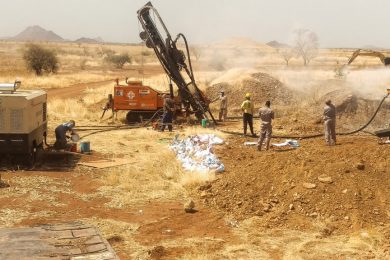The compact, modular, Multitec range have been Dando’s best-selling rigs over the last year. The Multitec 9000 in particular has proven desirable for miners and prospectors conducting exploration and grade control programs. The power and capability of the rig, the company reports, “coupled with its small size and low operating and servicing costs, prove a compelling alternative to traditionally larger, less efficient machines that require substantial capex investments.”
Weihai Donaqbao Mining, operating in Sudan, recently purchased a track mounted Multitec 9000 with accompanying trailer mounted Doosan 700 cfm/300 psi compressor for prospecting a concession in Gedaref State.
Targeting gold deposits, the project currently has two stages. The first is for forty-five, 4” RC boreholes between 100 and 150 m, drilled at angles between 60o and vertical depending on the orientation of the formation. Stage two is for H wireline core drilling to provide further information in select areas.
Features that come as standard on the rig lend the Multitec 9000 to projects like the one in Gedaref State. A hydraulic mast dump provides angle drilling from 45o to vertical and the high speed, high torque rotary head supplied with the rig allows it to be used for both conventional and wireline coring, RC drilling, DTH hammer drilling and open hole boring with either mud or air flush. The rotary head stroke enables the loading of 3m rods, while the hydraulically deployed mast extension saves tripping time through pulling two rods at once using the winch.
Despite its 10 t of pullback and 142 hp turbo-charged diesel engine, the Multitec 9000 is mounted on a compact crawler unit that is only 1,420 mm wide when tracking. The rig is also offered as a truck mounted unit on a heavy duty 4×4 truck, or on a trailer or standard skid to be mounted on a customer’s own truck. A hydraulic load-sensing system ensures that oil is delivered to the components that are working hardest, while reducing pressure to inactive components. This improves overall efficiency and reduces wear and maintenance costs.










